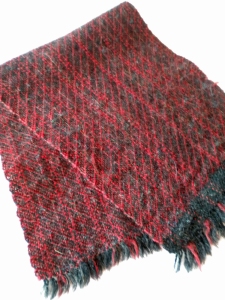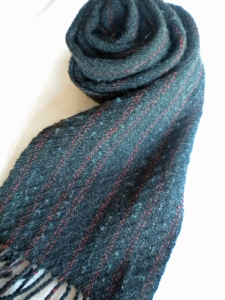This week I’ve been working on some wool scarves since we are moving into the cooler fall weather. I had some slate Shetland wool and some cranberry Jaggerspun wool, both 2/8 weight, that I thought would go well together. And for an added interest, I put in a few threads of some iridescent black rayon which has quite a “hairy” look. I thought a little fluff in the scarves would be nice.
I sett the warp fairly loose, just 16 ends per inch, to give the wool room to bloom in the finishing process. (What a difference from the 52 epi satin weave on my other loom!) I also focused on beating very lightly, 15 picks per inch. I didn’t want to make a stiff board – I’ve done that before and that scarf was not very pleasing!
I haven’t woven that much in wool and I approach the finishing cautiously. Wet-finishing (basically washing) is necessary to make the fiber bloom. The combination of heat and agitation opens up the fiber. Not enough agitation and the fiber remains somewhat stiff. Too much agitation and it felts. So I had to experiment to find the “Goldilocks” amount of finishing for this wool. What is “just right?”
Fortunately, I had half a yard of warp at the end that I could play with, so I wove it up the same as the scarves and took it to the wash machine. It didn’t look like it was finished yet after one minute of agitation, so I left it in for another minute. Then I laid the sample out to dry flat.
The wool opened up nicely, resulting in a soft and light-weight fabric. The rayon fibers did not fluff like I’d expected, so I gave the surface a little brushing. More vigorous brushing would be necessary if I really want the rayon to come to the surface. It will probably work its way out as the scarves are worn, but for now, the rayon just gives the surface a slightly grey cast. The rayon also didn’t shrink up the same as the wool, so there is a little rippling. That is to be expected when combining different fibers, but I’m glad I didn’t use too much of it.
Now I had a little more confidence in how to finish the actual scarves. I chose to agitate in very warm water for 1 ½ minutes only and rinse in the same temperature water. This is not a project I could pop in the washer and walk away—it needed to be watched to prevent felting.
All in all, this was a good learning experience. I may have more wool to work with in the future since I have lots of fiber to spin in my closet. From this comfortable starting place, I can consider more wool projects in the coming year.
What is your latest learning project? Share your progress!




I haven’t done anything in wool (well, I’ve used silk/wool combo)–the wet finishing makes me so nervous! I do love to wear wool, though, so I need to take the plunge. Reading about your experience, and seeing the finished scarves, is inspiring
Thanks!